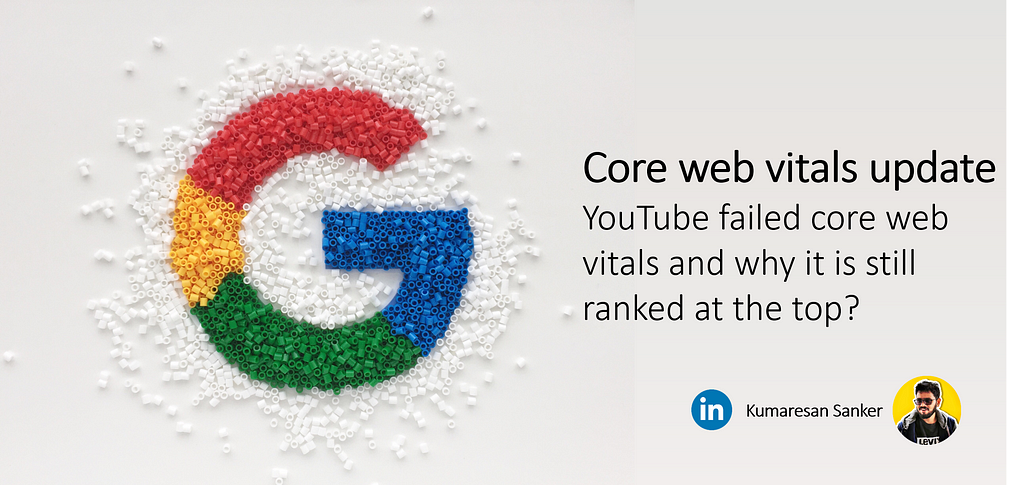This content originally appeared on Level Up Coding - Medium and was authored by Kumaresan Sanker

Google core web vitals update
Ever since Google entered the search engine space in 1997, it has dominated the entire search engine market. Google has over 92.81% market share in search engine. While most of the companies trying to rank and maintain their web pages at the top of Google’s SERP. Google is adding a whole new flavor to it. Google is now introducing core web vitals — LCP, FID, CLS and it is expected to introduce more vitals in the future.
However, is it necessary to shift your technology spend towards optimizing the core web vitals to improve your ranking?
Let’s take a brief look at how YouTube, a Google subsidiary, performs in its fundamental web metrics. To investigate this scenario, I used PageSpeed Insights to run a performance test for YouTube and collected origin field data (real-world data for all of YouTube’s pages) for both mobile and desktop.


From the above results, you can notice that YouTube has performed well in First Input Delay, poor in LCP, and needs improvement in CLS. Out of the three core web vitals, YouTube has passed only one. Still, you might see YouTube ranking at the top even after the algorithm update. Before jumping into why let us see how Google tried to push performance optimization from 2015.
· 2015 — Google announced AMP optimized websites will have the advantage to rank better. But most of the websites were not able to adapt to AMP.
· 2016 — Google demoted webpages with intrusive interstitials like ad popups.
· 2017 — Google introduced better ad standards to improve web experience without annoying ads.
· 2018 — Google launched mobile-first index to boost crawling of the mobile versions of websites in indexing.
· 2019 — Google partially introduced speed badging to identify a fast or slow website.
· 2020 — Google announced that it would roll out Google page experience standards by May 2021
· 2021 — Google informed about the delay in rolling out page experience update from May to mid-June and plans to gradually implement algorithm update till the end of August.
Google spent six years strategizing and implementing page experience guidelines. After too many unsuccessful attempts, Google is finally taking performance and SEO seriously. But we’ll have to wait and see if Google’s latest algorithm tweak is successful. Only time will tell!
Coming back to YouTube, it is a different scenario. User signals like time spent on a webpage, click-through rate plays a major role in YouTube. On average YouTube has more than 33 billion visits per month, nearly 11 pages per visit, and on average a user spends more than 21 minutes in YouTube. If your website has this much traffic and better user signals like YouTube, you can skip the core web vitals update. Rest of them must start optimizing their website's performance at the earliest. Because Google may roll out more vitals in the future and if your competitor is ahead in the game it is going to be tough for those who did not optimize.
“Experts agree that neglecting to prepare for the Google latest update could mean a 100 percent drop in website rankings and a significant decrease in traffic and conversions.”

Another situation is that you may not experience an improvement in search results even after optimizing the three fundamental web vitals if your rival has optimized the vitals better than you. The next stage is to concentrate on additional indicators, of which there are a total of 15 to consider in order to optimize your SEO. In our next article, we’ll go through the additional vitals. Keep an eye out!
YouTube failed core web vitals, why it is still ranked at the top? was originally published in Level Up Coding on Medium, where people are continuing the conversation by highlighting and responding to this story.
This content originally appeared on Level Up Coding - Medium and was authored by Kumaresan Sanker
Kumaresan Sanker | Sciencx (2021-06-18T14:29:55+00:00) YouTube failed core web vitals, why it is still ranked at the top?. Retrieved from https://www.scien.cx/2021/06/18/youtube-failed-core-web-vitals-why-it-is-still-ranked-at-the-top/
Please log in to upload a file.
There are no updates yet.
Click the Upload button above to add an update.
